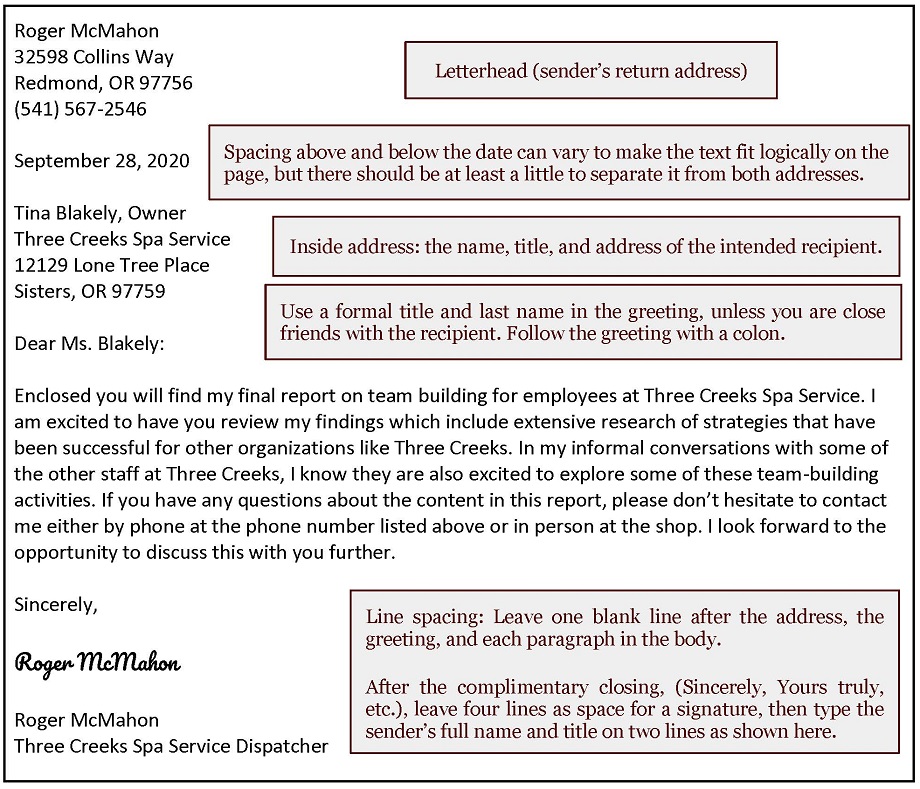15 – Correspondence
Letters
Annemarie Hamlin; Chris Rubio; Michele DeSilva; and Claire Carly-Miles
Letters are usually brief (one to two pages) messages sent to recipients outside the organization. They are often printed on letterhead paper and represent the business or organization. While email and text messages may be used more frequently today, the effective business letter remains a common form of written communication. Letters may serve to introduce your skills and qualifications to prospective employers, deliver important or specific information, or serve as documentation of an event or decision. All letters have expectations in terms of language and format. The audience may have their own ideas of what constitutes a specific type of letter, and your organization may have its own format and requirements.
This section outlines common elements across letters, and attention should be directed to the expectations associated with your particular writing assignment. There are many types of letters, and many adaptations in terms of form and content, but we will focus on the 15 elements of a traditional block-style letter. Figure 15.2[1] demonstrates a cover letter that might introduce a technical report to its recipient. Notice that this letter uses full block format, a widely accepted and professional choice. Full block format is left aligned (do not indent paragraphs) and single-spaced with a line space between paragraphs. Rely on this format for letters unless your employer requires something different.

Strategies for Effective Letters
Remember that a letter has five main areas:
- The heading, which names the recipient, often including address and date
- The introduction, which establishes the purpose
- The body, which articulates the message
- The conclusion, which restates the main point and may include a call to action
- The signature line, which sometimes includes the contact information
Always remember that letters represent you and your company in your physical absence. In order to communicate effectively and project a positive image, remember that:
- Your language should be clear, concise, specific, and respectful;
- Each word should contribute to your purpose;
- Each paragraph should focus on one idea;
- The parts of the letter should form a complete message;
- The letter should be free of errors.
This text was derived from
Gross, Allison, Annemarie Hamlin, Billy Merck, Chris Rubio, Jodi Naas, Megan Savage, and Michele DeSilva. Technical Writing. Open Oregon Educational Materials, n.d. https://openoregon.pressbooks.pub/technicalwriting/. Licensed under a Creative Commons Attribution-NonCommercial-ShareAlike 4.0 International License.
The above authors derived their text from:
Saylor Academy. “PRDV002: Professional Writing.” April 2016. Online Course. https://learn.saylor.org/course/view.php?id=56. Licensed under a Creative Commons Attribution-NonCommercial-ShareAlike 3.0 Unported License.
McMurrey, David. Online Technical Writing. n.d. https://www.prismnet.com/~hcexres/textbook/. Licensed under a Creative Commons Attribution 4.0 International License.
- Derived from: “Sample Cover Letter,” in “Professional Communications,” Technical Writing, by Allison Gross, Annemarie Hamlin, Billy Merck, Chris Rubio, Jodi Naas, Megan Savage, and Michele DeSilva, Open Oregon Educational Materials, n.d. https://openoregon.pressbooks.pub/technicalwriting/. Licensed under a Creative Commons Attribution-NonCommercial-ShareAlike 4.0 International License. ↵
Textual formatting style where text is left aligned and single spaced with a line space between paragraphs.

